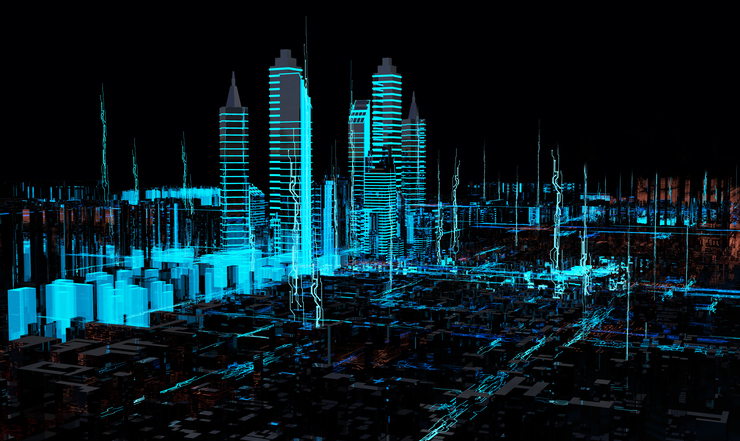Building Virtually - Reflections on Digital Twins in the CRE Industry

There is something about a good marketing term that really fires up the imagination and the term Digital Twin hits the right note. It sounds cool, so it must be a useful technology - right? The concept has been rumbling around for a while and it's time to clear up some of the confusion and clarify the solid opportunity.
A Digital Twin is a simplified data representation of an object. Boats, weather systems, cakes etc. all have familiar analogs in the form of cruise ship maps, dashboard KPI or delightful recipes. For my purposes, a digital twin is an online data representation of a structure and the activities that occur in it. Virtualization is another important term to note as it describes the process of making a digital copy of a physical entity.
Many vendors also include operational features and functionality when describing their product as a digital twin. This approach takes advantage of the operational desire for remote Command & Control functionality. Currently, this level of capability is only predictably available for HVAC systems. A better analogy is found in the automotive industry where five levels of autonomy for self-driving cars have been defined. Similar efforts are underway to create a baseline for comparing digital capabilities across buildings.
Digital twins need to strike the balance between detail and utility and investments in digital twins need to keep scale in perspective. The cruise ship map analogy works here. It does not need to show the average passenger the location of the engines, let alone locate them to a one-inch tolerance. It just needs to show the way to the pool and let them know what time the lunch buffet opens. When it comes to Digital Twins in CRE, use cases help keep the business case and extent of integration in perspective. There may be a technical ambition to model the entire building, but the business use case sets the boundaries of what systems are considered integral or optional to the investment.
When a building is virtualized, it is carved up into minimum viable architectural spaces described by static features like walls and pumps. These spaces are supported with dynamic services like heat and light. Collectively, the spaces describe the building as a whole and are documented using BIM.
FAQs on Digital Twins
Is BIM a digital twin?
Yes. BIM allows much greater accuracy when providing online documentation for construction and operation of a space. REVIT and other modeling techniques take this documentation a step further. By mapping building services, the model becomes increasingly accurate to the conditions the occupant is experiencing. The promise of virtualization and digital controls is to take this model to ever finer levels of granularity. Rather than set a temperature for a floor, a digital twin potentially allows for control at the meeting room level. This capability may be a significant differentiator as new technology services emerge. At the moment it is simply a framework to implement policy controls on a virtual space (property).

Can existing sites be digitized cost-effectively?
Yes. But sites gain most from integrating their smart systems with the online Twin. Both new construction and existing properties can be digitized by ensuring building documentation and device naming use consistent naming techniques. But beyond this simplified representation of the building, features and capabilities are provided by ‘smart’ automation. Digital Twins gain their power from accurately mapping locations and their services.
The concept of a building as a collection of spaces also allows for space management across properties. Virtualization allows the building (space) to be managed in different aggregations thereby leveraging scarce expertise or economies of scale. One example is surveillance camera systems (DVMS) which are often aggregated into multi-building command centers. Another is the highly desired feature of every call center - an ability to remotely control the lighting on behalf of occupants. By aggregating and virtualizing lighting controls the service can be cost-effectively provided across a portfolio. We need to stop thinking of the building as an aggregated whole of services and start thinking of buildings as aggregations of individual spaces and their services; each space needing different services delivered dynamically in different ways appropriate to their use case.
A favorite project is Bell’s Lightbox in downtown Toronto. As home to the Toronto International Film Festival, it needed to cater to every possible movie format and scale delivery to allow for multiple (unpredictable) audience sizes. It was built to accommodate both analog and digital formats. Although an underappreciated technical marvel (it’s over 10 years old already); it is really a marvel of service delivery for cinema. Each cinema space is dynamically adjusted to on-demand need. Lightbox is an early example of how services can be used to organize a digital twin but not delivery technology.
What do I have to get right when building a digital twin?
A strategy to ensure naming is consistent across locations and services. One objection at this point is: we already have systems that do everything you just said. Why do we need to virtualize the building as an aggregated whole? The problem is that each of the existing subsystems address space and service using their own terminology and operational techniques. Heat is applied to a zone, whereas electricity is measured by circuit and elevators measured by wait time—and all of these systems are limited by how the service was originally installed. Managing the space as a whole requires correlating services by location, not subsystem.

What is the biggest unresolved issue in the transformation?
Who is running the Command & Control - the Twin, the local Operator, or the Occupant? In these early days of virtualization, there will be a lot of troubleshooting and fumbling trying to get a consistent operational model in place. The fundamental tension is clear. Currently, local building operators are aware of their systems and their special needs. They can respond to occupants directly and are in tune with capital plans to upgrade. When a problem emerges, the local operator is in control. But eventually the efficiencies of command and control using a digital twin will need to override a local operator. Coordination and change management are essential. This is the same challenge of machine learning being experienced in many domains.
At minimum, Digital Twins promises to broadly change how we manage space within CRE. As Dean Hopkins, EVP and COO of Oxford Properties points out: “While most people think of Twins as having use cases only for Development personas, there are clear use cases across Investment, Asset Management, Property Management, Leasing and Operations.”
Hear more from Matthew Lennan about Oxford's Digital Twin projects on March 12 at the Realcomm Webinar, Smart Building DIGITAL TWINS – Demystifying the Building Visualization Technology. Register today at www.realcomm.com/webinars.
This Week’s Sponsor
DroneDeploy is the leading drone software solution trusted by over 5,000 companies across a variety of industries, including construction, energy, agriculture, mining, and real estate/property management. DroneDeploy makes aerial data accessible and productive for everyone. Simple by design, DroneDeploy enables professional mapping, 3D modeling, and reporting from any drone on any device. www.dronedeploy.com
Read Next
 3/27/2025
3/27/2025
The Convergence of Edge Computing, Cloud, and AI in Building Automation and Smart Buildings In the built environment, we have seen the convergence of Operational Technology (OT) and Information Technology (IT), later expanding to include Workplace Technologies (WP).
 3/27/2025
3/27/2025
DC Power: A Holistic Approach to Energy Savings in Commercial Buildings In today's energy-conscious world, businesses constantly seek ways to reduce their carbon footprint and operational costs.
 3/13/2025
3/13/2025
How to Achieve Eco-Friendly Facility Management Commercial real estate operators and facility managers are focusing on sustainable practices to minimize environmental impact, create healthier workplaces, improve productivity and lower operational costs.
 1/23/2025
1/23/2025
When It Comes To Managing Properties’ Parking, Technology Is Key It’s easy for developers and real estate owners to think of parking as a necessary evil. They know they have to provide it (often, because it’s mandated by code), they understand that prospective tenants and buyers expect to be provided parking, but they haven’t figured out how to maximize its value.








.gif)


